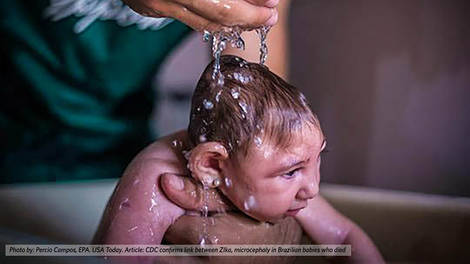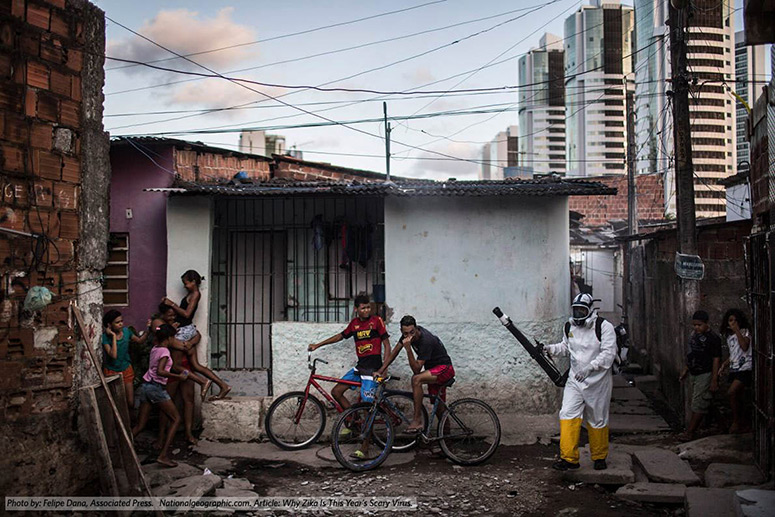
Viral Virus: the role of media and paranoia in the fight against Zika

We all remember the Ebola outbreak. How could you not? It was slammed across news headlines and stories everywhere: people in hazmat suits, bodies, calls for quarantine, and travel bans. Today, a new virus, Zika, is causing similar global alarm among citizens and public health experts. This is particularly true in Latin America, where countries like Brazil are reeling from the fast-moving epidemic. Already, news stories warn that the Zika virus outbreak in Latin America may become a bigger threat to global health than the Ebola epidemic that killed more than 11,000 people in Africa.
Zika as major global threat
The Zika virus is not a new phenomenon as the initial discovery of the infection was in 1947. However, Zika infection was again confirmed in Brazil in May 2015 and continues to spread quickly. As of February 29, 2016, Zika infection has been found in 31 states in the Americas, four in the Pacific Islands, and one state in Africa [1]. The World Health Organization (WHO) has estimated that 3 to 4 million people across the Americas may be infected with Zika within the next year.2
The virus is primarily transmitted by a bite from the Aedes mosquito. The Centers for Disease Control and Prevention (CDC) has verified other possibilities of transmission from an infected pregnant mother to her child, through sexual contact with an infected man or woman, and through blood transfusion.
On February 1, 2016, the WHO declared a Public health Emergency of International Concern due to the large numbers of birth defects named microcephaly recently found in areas affected by Zika. Microcephaly is a birth defect that causes a baby’s head, and often their brain, to develop smaller than other babies in comparison. The potential tie of Zika to newborn birth defects — while unverified — has supported widespread paranoia of exposure to the Zika virus.
According to Brazil’s Ministry of Health, as of now, scientists have confirmed 404 cases as microcephaly and ruled out 709 cases of the over-reported 4,700 suspected cases of microcephaly.3 Fears of the microcephaly linkage to Zika led pediatric cardiologist, Dr. Sandra Mattos, and her team to check hospital records for data of head circumferences from 100,000 newborns born in the last four years in Paraiba, Brazil.4 This research discovered mild microcephaly cases that are borderline and date back to at least 2012-- far before this recent Zika outbreak. The connection between Zika infection and microcephaly is still under investigation.
Ana Carolina Caceres is a 24 year old Brazilian journalist who was born with microcephaly and continues to lead a normal life. In the midst of the current uproar, on February, 2, 2016, Caceres told her story in an interview with BBC News Latin America commenting, “But what I recommend to mothers or pregnant women is that they remain calm. Microcephaly is an ugly name but it’s not an evil monster5.”
For most people, Zika virus produces a very mild illness, according to the CDC. Only about one in every five people infected with the virus become ill with common symptoms — fever, rash, joint pain, or conjunctivitis —that do not require hospitalization. These last for several days up to a week. During that time, the CDC recommends patients get plenty of rest, drink fluids to prevent dehydration, and take acetaminophen to relieve fever or pain.
Health Experts have less to say about how to prevent getting Zika. There is currently no vaccine to prevent Zika. For now, WHO officials are promoting use of insect repellent to prevent mosquito bites and suggest people use mosquito nets in tropical countries. They urge people to avoid traveling to Zika zones unless necessary.
Viral Confusion
The lack of concrete scientific facts about Zika has led to many questions by a frightened global public. With 80% of microcephaly cases being reported in the northeast region of Brazil, people have asked why microcephaly is not following the exploding Zika trend seen in other countries of Latin America.6 Why are mothers in Brazil so disproportionately affected?
The media coverage hasn’t helped. As reporters rush to cover a rapidly evolving story, many have pushed unverified ideas about how Zika is spread, fueling theories. Theories range from global elites attempting to depopulate the earth for a one-world government to evidence suggesting Zika is linked to the use of Monsanto anti-mosquito insecticide spraying in poor Latin American countries.7 The Monsanto connection has triggered anger from local communities against the globally condemned multinational corporation pushing genetically modified seeds and harsh insecticides on poor countries that now may be involved in causing a global health threat.
Medical professionals across the globe are asking these questions too. “I would ask my toxicological colleagues in Brazil to please look very closely into the practical application of agrochemicals in their country,” stated Dr. Christoph Zink, an epidemiologist in Berlin in a recent interview with CBC News Health.8 He’s worried about the pesticide theory.
CBC News Health on February 10, 2016 writes on why the 2,100 pregnant women affected with Zika in Colombia have not been associated with microcephaly risks unlike those affected in Brazil.9 Mattos and colleagues present in a research paper for the Bulletin of the World Health Organization some potential factors that may cause “an intensifying effect” in microcephaly such as boosting effects from other infections, exposure to agents that cause birth defects like drugs, or malnutrition.10
Effects in Latin America
Across Latin America, the Zika-affected are becoming stigmatized. The burden falls disproportionately upon poor populations living near open water sources that attract mosquitoes, and who do not have the resources to protect themselves individually through bite prevention methods.
Fear of Zika is also causing a fear of contamination by Brazilians and other citizens of Latin American countries. This paranoia mirrors what we saw in the recent Ebola response. Then, Africans were subject to quarantine and travel bans, including US citizens from countries outside the Ebola hot zones. With Zika, Brazilians are feeling the stigma, especially pregnant women. Warnings for emergency action climax public paranoia. While women are urged to avoid pregnancy, the CDC is advising abstinence of men with a pregnant partner.11
U.S. Fears
While the outbreak of cases impacts some 30 countries in the Americas, Pacific Islands, and Africa, Zika has also gone viral as a news topic in the United States, largely due to the suspected Zika virus tie to microcephaly in newborns. “If you’re pregnant, and you’re thinking about traveling to a place where Zika is spreading, please don’t,” warned CDC director Tom Frieden on CNN.12 His statement reflects the CDC’s warning for pregnant women to avoid all travel to the Americas and Pacific Islands in order to protect their babies.13 Worry among Latin Americans of such travel bans and closing borders is fueling a backlash of stigma affecting Latin Americans.
Different disease, different fight
For now, Zika is presented as an image of Brazil overcome with mosquitoes and mothers with their babies in impoverished homes. Photos of children with underdeveloped heads and disproportionate features fill newspapers.
Given the heavy toll on Brazil, some Brazilians have charged that Zika media stories are fueling racism. Historically, the First World criminalizes the Third World as carriers of illnesses. This was true with Ebola and is now true with Zika. The media hype is similar to Ebola, marked by international stigma and panic.
The Ebola outbreak led to global panic and a chaotic public health response. Now with Zika, massive spraying and police canvassing of towns to eradicate Aedes mosquito larvae signal a similar panic marked by uncertainty of how to stop Zika.
 President Obama recently requested $1.8 billion of emergency funding from Congress to combat Zika.14 These funds will provide mosquito control programs, vaccine research, and improving health care for low-income pregnant women with $355 million going towards foreign aid in the Americas and Caribbean.15 Some of that money is being diverted from the Ebola program.
President Obama recently requested $1.8 billion of emergency funding from Congress to combat Zika.14 These funds will provide mosquito control programs, vaccine research, and improving health care for low-income pregnant women with $355 million going towards foreign aid in the Americas and Caribbean.15 Some of that money is being diverted from the Ebola program.
But that’s caused problems. After a recent briefing with Senate leaders, Health and Human Services Secretary Sylvia Burwell said separate funds are needed. “We need to finish the job in terms of Ebola,” she stated.16
Certainly Zika and Ebola are different diseases and need to be treated differently. Ebola offers lessons for both public health decisions and the role of leaders in informing the public about Zika. One key lesson is to base public health responses on science and educate the media to report responsibly on Zika.
“We have to deal with an unknown enemy, a big problem, a major disease, a new disease that has changed, an environmental problem we don’t know,” said Mattos summing up key challenges with Zika. “At the same time, we need time for science to run its routines. We have tremendous pressing needs of the population, pregnant women, women of reproductive age, for quick answers”17. But good science remains vital.
That’s what the WHO is doing. The health agency recently released a Strategic Response Framework & Joint Operations Plan for January-June of 2016 that calls for sound emergency health policies for Zika focused on maternal and fetal health. This focus should aim to directly help hard-hit, impoverished communities in Brazil and other areas where the Aedes mosquito is mostly found.
“Our goal really is to protect pregnant women,” stated CDC director Tom Frieden pointing out a priority group needing help.18
Applying field lessons
“I think we jumped a little bit too fast into Zika. It may be well…but just saying there are a few things that don’t seem to kind of match very easily in this picture and that we may need to investigate a bit further,” Mattos admits to CBC News Health.19
As scientists work to track Zika, media and public officials must take the lead in diminishing public paranoia that fuels international stigma for those with the virus. One important lesson from Ebola is that local communities are best placed to tackle provisions for support, education, and resources now in fighting Zika.
As with Ebola, WHO and CDC officials are again pressed for information by a fearful global public. While it may take researchers time to investigate the connection of Zika and microcephaly, speculation can’t take place of good science. Ebola has taught us that.
Notes:
- https://www.cdc.gov/az/a.html
- http://www.cnn.com/2016/02/05/health/zika-urine-saliva/
- http://www.cbc.ca/news/health/microcephaly-brazil-zika-reality-1.3442580
- http://www.cbc.ca/news/health/microcephaly-brazil-zika-reality-1.3442580
- http://www.bbc.com/news/world-latin-america-35461429
- http://www.cbc.ca/news/health/microcephaly-brazil-zika-reality-1.3442580
- http://www.nytimes.com/2016/02/17/world/americas/conspiracy-theories-abo...
- http://www.cbc.ca/news/health/microcephaly-brazil-zika-reality-1.3442580
- http://www.cbc.ca/news/health/microcephaly-brazil-zika-reality-1.3442580
- http://www.cbc.ca/news/health/microcephaly-brazil-zika-reality-1.3442580
- http://www.cnn.com/2016/02/05/health/zika-urine-saliva/
- http://www.cnn.com/2016/02/05/health/zika-urine-saliva/
- http://www.usatoday.com/story/news/2016/02/10/cdc-confirms-link-between-zika-microcephaly-brazilian-babies-who-died/80179898/
- http://www.usatoday.com/story/news/2016/02/10/cdc-confirms-link-between-...
- http://www.usatoday.com/story/news/2016/02/10/cdc-confirms-link-between-...
- http://www.usatoday.com/story/news/2016/02/10/cdc-confirms-link-between-...
- http://www.cbc.ca/news/health/microcephaly-brazil-zika-reality-1.3442580
- http://www.usatoday.com/story/news/2016/02/10/cdc-confirms-link-between-zika-microcephaly-brazilian-babies-who-died/80179898/
- http://www.cbc.ca/news/health/microcephaly-brazil-zika-reality-1.3442580
